You will love the Dutch city of Delft, one of the most famous, historical and beautiful towns in the Netherlands, preserved in picture book perfection. It's also a modern city that functions very well for its 100,000 residents as you're going to see in this comprehensive guide.
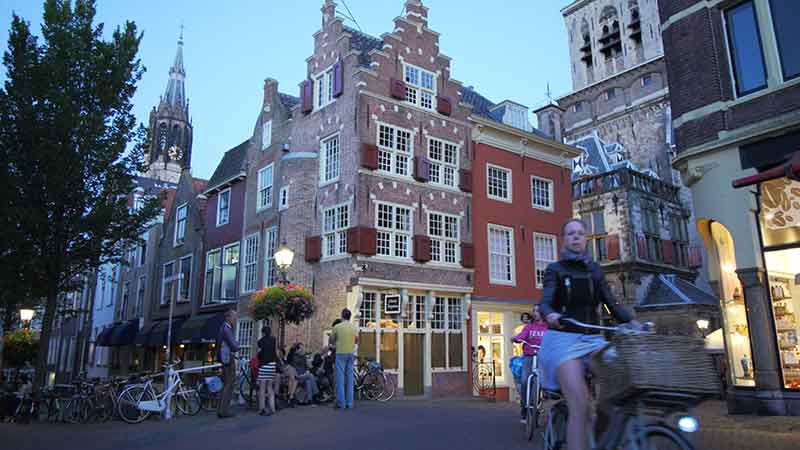
It's a town of bicycles, canals, cheese and beer, typical of the Netherlands, with friendly, well-educated people, excellent preservation of historic buildings, many of them 400, 500 years old, in a compact historic old town, about one-half square kilometer in size. Delft is very easy to cover walking around on foot.
You'll find many outdoor restaurants, especially in the big market square. It would be quite okay if your main activity in the visit is just sitting at a terrace restaurant having a beer, soaking up the historic atmosphere. We will take you there, show you a calm day and we will show you a busy market day right in the center of town. With over 500 stores and several street markets, shoppers will find much to love.
And later we'll take you to the ultimate shop where they manufacture and sell Royal delftware, the classic product this town is most famous for.
View 39-minute complete video of Delft:
Perhaps your main activity here is simply walking around enjoying the extensive pedestrian zone. No cars, quiet lanes, little canals. Even in the evening it's a charming spot to be out walking, or you could rent a bicycle.
It's so easy to reach Delft by train using the excellent Dutch rail system. You'll find the Netherlands is a relatively small country, easy to get around. From Delft to Amsterdam is only one hour by train.

The new station is a spectacular contrast to the old buildings of the historic center. A bridge leads from the station across the canal right into town where you'll cross the tram tracks and plunge right into the historic center.
It's only a few blocks from the train station into the old town, and you're quickly in the middle of things. Head north a few more blocks to walk to the direction of the central market square. You won't need a taxi to get your hotel, just walk and notice the beauty of these buildings.
If you've arrived in the evening you'll find it's an especially magical time. In that case a good first stop is have a beer outside at twilight, then find a cozy restaurant for a lovely meal.
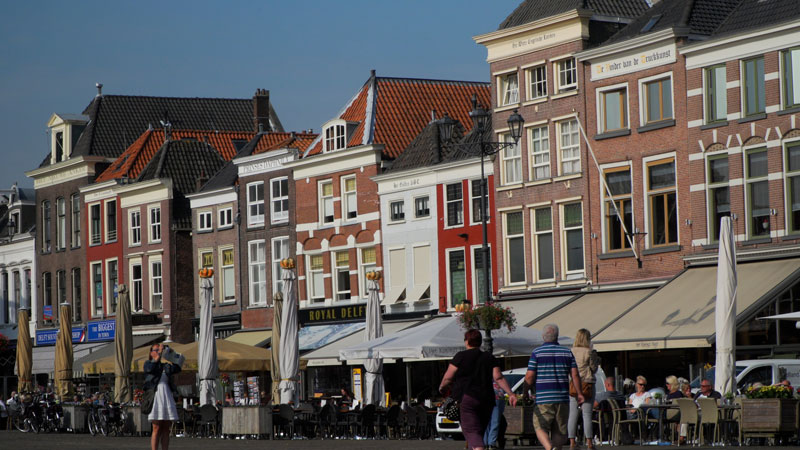
Simply called the market or de Markt, this main square will be the center and focus of your activities in Delft with the new church at one end sporting the second-highest bell tower in the country, and the City Hall at the other, and of course with shops and restaurants all around. We will also take you walking on those nearby streets along the beautiful canals and see more shops all around the center. It's a small area, easy to explore in a relaxed pace.
You could get a feeling for the city with a one-day visit, walking around in the market square and checking out some of the nearby blocks, but you'll see it's much more worthwhile to spend a couple of nights so that you can really relax and enjoy the special charms of this place, perhaps best in the shoulder season like September, when it's nice and quiet and peaceful.
They get a million annual visitors, mostly in the summertime, but that's nothing compared to the crowds that you're going to run into in Amsterdam, which unfortunately is the only place that many visitors to the Netherlands ever see.
And while Amsterdam is a wonderful destination that you must visit, it would be a shame to stop there and miss out on all these other places in the country that we present in this website.
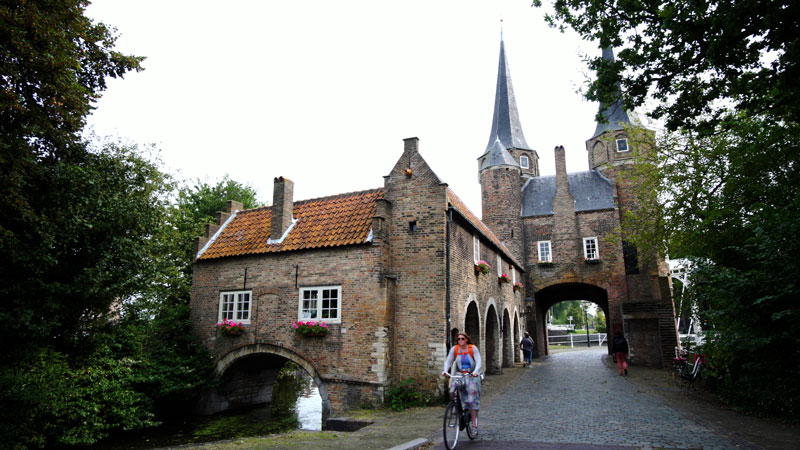
We had a nice talk with George Stroomberg, the owner of one of the cafés, Van 9 tot Zeven, on the market square here who filled us in on his feelings about Delft.
"You're here in Delft and you want to know why people should come to Delft? We have a lot of old buildings of course in Delft, which is very nice. Everything you can do in the cities you can do it by feet, so you don't have to use a bus or tram or train, you could just walk here. And it is like is like a fairytale actually, that is what I think about.
"And then there's the little canals. You can make a round-trip by boat, markets, flea markets so you can come buy small things with the flower market, there is a grocery market every Thursday. So there is a lot to see in the city, what you really like, what people normally like. There are a lot of terraces and restaurants. You can eat on the boat, or you can eat on the square. You really feel in the 1600s when you sit here. Very well preserved, historic. Yeah we've got people like to, to keep their things very nice and in very good shape.
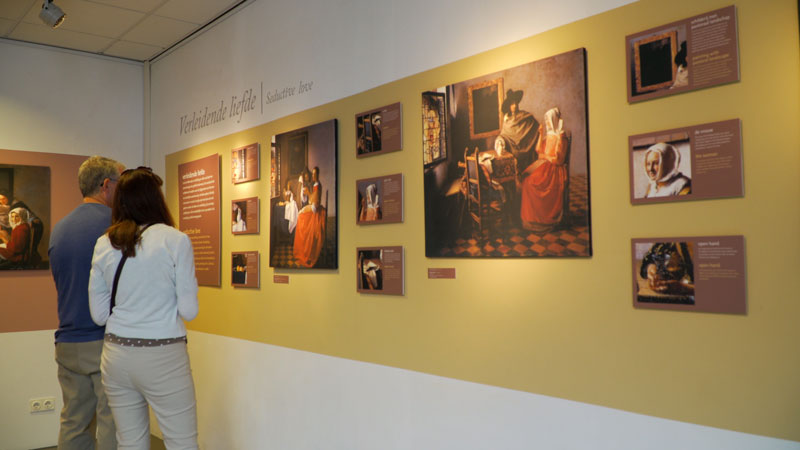
"And of course we have a lot of painters. We have art museums, the Vermeer Museum. Nice painting of Vermeer, the street of Vermeer, his house where he has been born is in this town as well. You can visit as well.
"It's nice to be here for a couple of days and then you can see all the town if you like. Very relaxing. Very relaxing because it's a student city as well. There are about 15,000 students, so it gives a very good energy to the city. People live here, yeah they live above the businesses. People bought it long time ago and keep it in the families. And not many cars.
"You can park your car on the edge of the center and you just walk into the center. You only have to watch out for bikes, that's the only thing."The large building at one end of the market is the City Hall. It was the Palace of Justice before that. They still have some city offices, but now it's mostly just for people to get married.
"One of the most important things why people come to Delft is because our Royal family is buried here in the church, with the monument and mausoleum of William of Orange."
George's café is a nice place to eat. I had a lovely brunch there. You'll easily find it right on the main market square. They also serve lunch, and salad, soup, you can get an early dinner and of course they serve beer and wine.
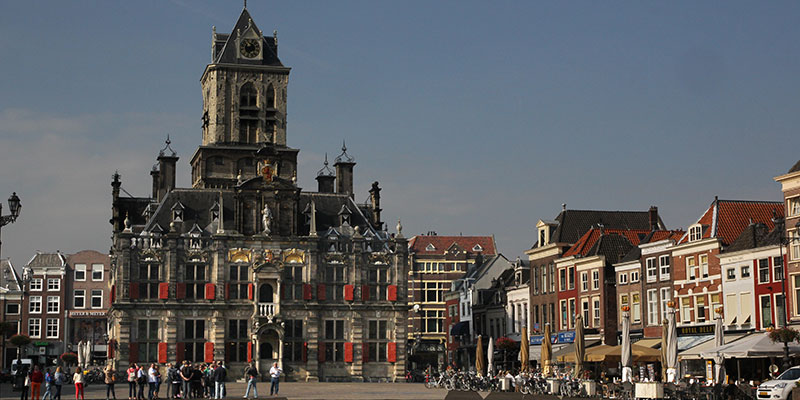
The tower that rises above City Hall is considered the city's oldest surviving building dating back to 1300. It's the remains of the fort of the Dukes but lightning struck in 1618 burning down the rest of the building. They were able to save the tower, and then later in the 17th century they constructed a new City Hall (Stadhuis) in a Renaissance style as a U-shaped building to wrap around the tower.
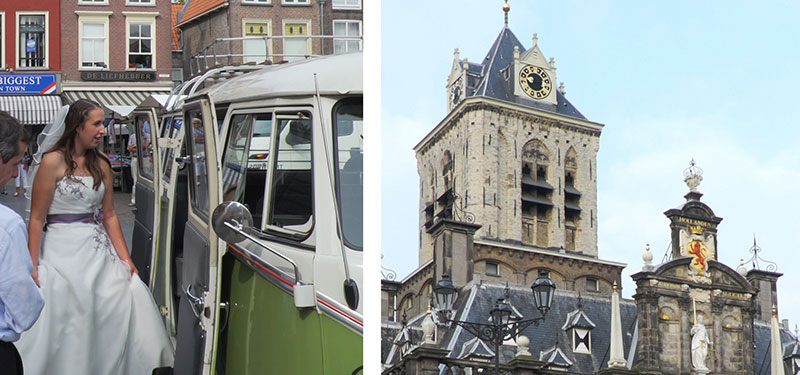
Although it is no longer the main City Hall, there are a few government offices still in the building, and weddings often take place here.
Behind City Hall is the House for Butter, a very important product back in those days. Now it's a restaurant, Grand-Cafe-Diner 't Boterhuis, like many of the other buildings around the square. We are so fortunate as English-speaking tourists, there is never a problem in communicating, so menus nearly always have English translations for you.
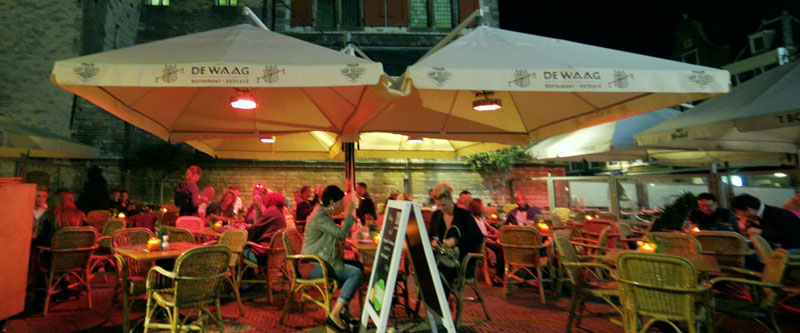
There are a couple of other excellent restaurants just behind the City Hall. The Grandcafé is open from 9:30 in the morning until 1 AM. You could sit indoors but it's so much nicer outside in the evening. And the Waag. Both are very popular with a local clientele so much that their websites don't even have English language version. However, of course, Dutch speak English. And throughout the market square in front of that tall church tower, you'll find many more restaurants.
Back in the Markt, you'll find a nice variety of visitor-oriented shops selling cheese, souvenirs, clothing and the famous pottery is everywhere. Surprisingly it's not a touristic rip-off kind of place because it's also shopping area for some locals as well. It's a place where they go through many barrels of beer.
Hugo Grotius, standing tall as a statue, was a Delft native whose writings in the early 17th century laid the foundation for international law. He was the first to describe the world as a society of states held together by mutual agreements rather than force.
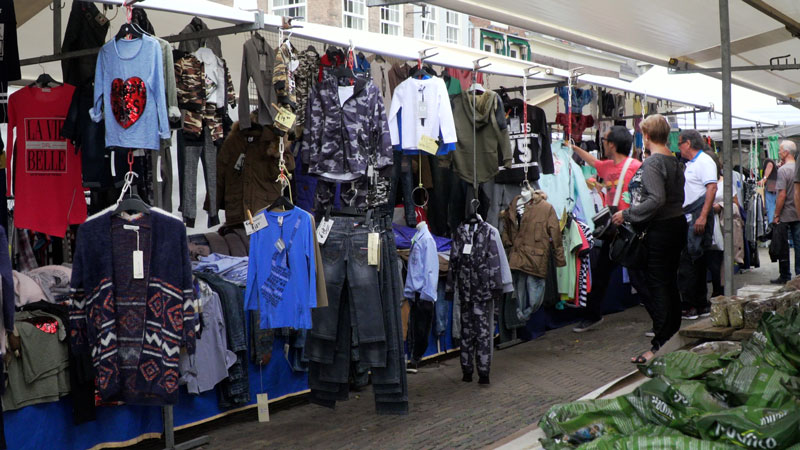
The market gets very busy every Thursday- it's market day, people flock here and you'll notice that most of the shoppers are locals. They're here to buy produce, get fresh vegetables, pick up lunch and candies, get some cheese, chat with their neighbors and generally enjoy this atmosphere which has been going on, they say, for over 500 years in this same location.
Throughout that Golden Age of the 17th century, Delft played a major role with its own harbor, along with the larger cities of Amsterdam, Rotterdam and several other ports. At the same time Delft had a strong economy with production of textiles, butter, cheese, and 200 breweries, using slightly polluted canal water that was then made drinkable by using it to make beer.
During the 17th century Delft was enjoying an artistic Renaissance and scientific breakthroughs, with the career most famously of Vermeer, and also the scientist Anthony van Leeuwenhoek, who invented the microscope and created the science of microbiology when he discovered bacteria.
Is that why Dutch cheese is so good? I mean, the combination of science and arts and agriculture and trade somehow has given us this wonderful food, and quite affordable. Here you get a kilogram for 10 euro.
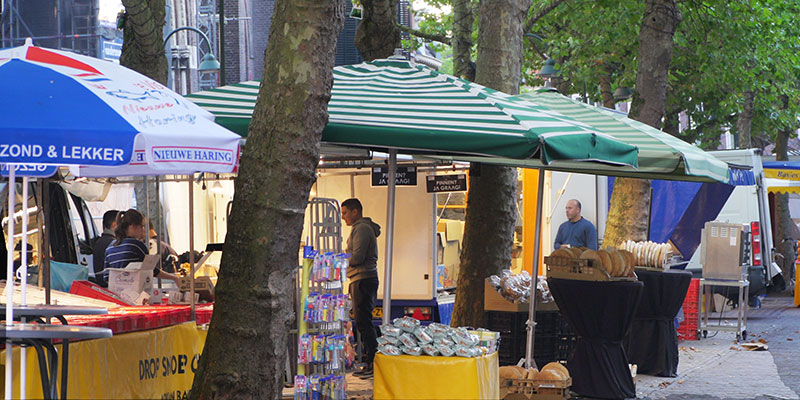
Now let's shift over to the other market that happens in Delft at the Turfmarkt. It's smaller than the Thursday main market, but still really charming. Primarily a food market, it gets started before 9 o'clock in the morning. Nearly all of the shoppers are local. Easy to find, it's located just one block south of the main market square.
It's always nice to have a look at the local markets when you travel, and each city takes its turns. There is usually two, sometimes three markets per week in each place. We are here in Delft on a Saturday morning.
And it's a local affair, it is a relatively small market for produce, vegetables, fruits, fresh breads and just a place to have a look and poke around. Of course they do have supermarkets here in Delft, but it seems that the locals prefer coming out and buying their foods fresh, and certainly when the market appears on a Saturday morning.
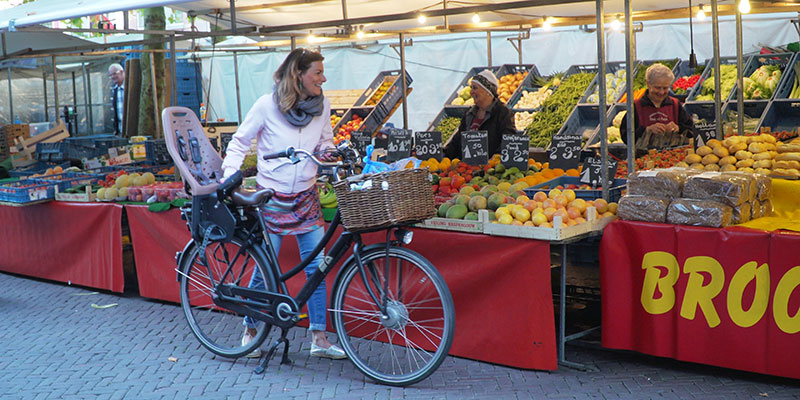
You can tell that the shoppers here with their bicycles are regular customers. With the food basket on the front and a children seat in the back, the bicycle is your basic family vehicle, a Dutch version of our SUV. This country has 17 million people and 23 million bicycles.
On Saturdays Turfmarkt is a general market with some flowers sold, but on Thursdays, the same place has a bigger flower market. Along with the famous tulips, the Dutch grow a wide variety of blossoms – it's a big part of their economy. There are some ready-to-eat food, so you will not go hungry here. Maybe pick up some bread to go with your cheese and fruits, and you've got yourself makings of a nice picnic. Love that dark bread.
It's called Turfmarkt because it used to be a canal where they brought in turf or peat, that decayed soil that was used as a fuel for the breweries which were major Delft industries back in the Middle Ages. And the canal was filled-in in the 19th century and became this very useful tree-lined plaza. It's one of the main open-air spaces of Delft, which of course has a number of outdoor restaurants that are open every day in the fair weather.
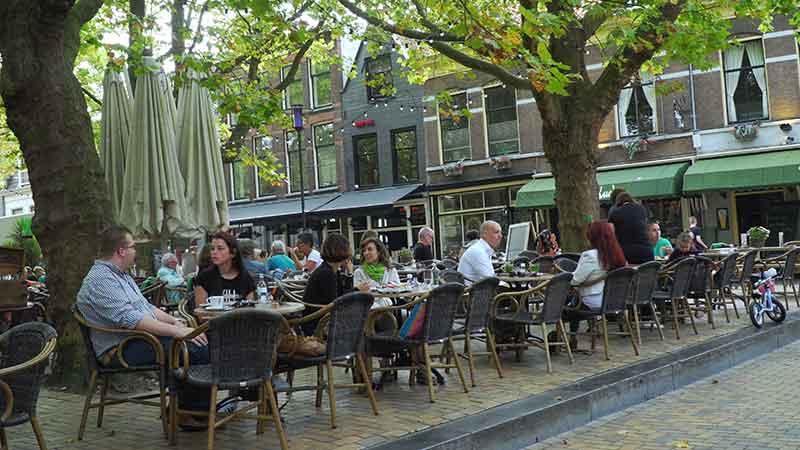
It's an ideal tree-shaded plaza surrounded by restaurants and bars, with indoor seating as well as outdoors on the terrace, a great place to hang out and relax. It's a lot more peaceful now than in its early days when it was the animal market square, the Beestenmarkt where they sold the cattle and prior to that back in the 16th century, it was a monastery.
Later in the 20th century it became a parking lot and it wasn't until the late 1990s that the parking spaces disappeared and this lovely entertainment center was created, surrounded by 11 restaurants.
Spijsuis de Dis is one of the best restaurants in town. According to Trip Advisor, it ranks number 3 out of 200 restaurants in Delft, with that cozy interior and a friendly, helpful staff. I had an excellent meal in here.
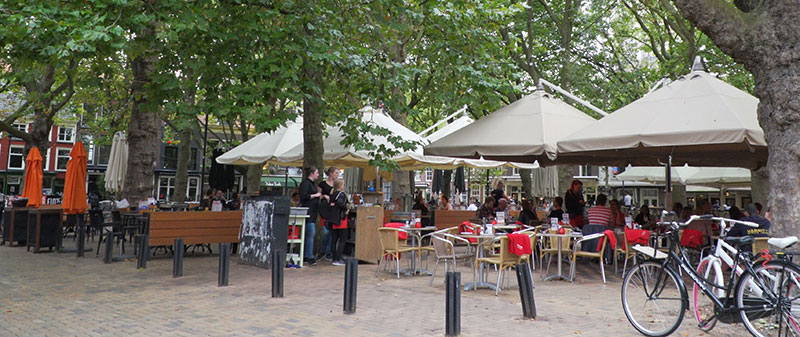
The restaurant has a big menu with 15 different meat and fish entrées, and four different vegetarian choices, washed down with a lot of good Dutch beer. Typical price for an entrée is in the mid-20 euros, or you could just have an appetizer and a drink. But make a reservation if you're going for dinner.
Just around the corner from the Beestenmarkt along a lovely canal is the location of the hotel that I stayed at for my three nights in Delft, and had a chat with the owner, who described it, and the surroundings.
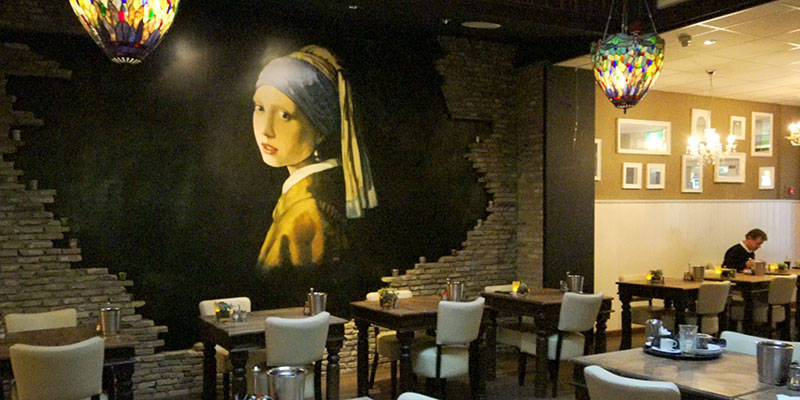
"Welcome to the Hotel Johannes Vermeer, located in the city center of Delft. We are famous for our wall painting of the Girl With the Pearl Earring, well known as the famous picture of Vermeer. We're here at the Molslaan, one of the nice little streets of Delft, with a lot of convenience stores, we have a nice shoe store and flower market every week. So it's really nice to walk around here, walking distance of all the nice points of interest of Delft – the big market square with the City Hall and church. Even the station is in walking distance, within 10 minutes you are at the train station.
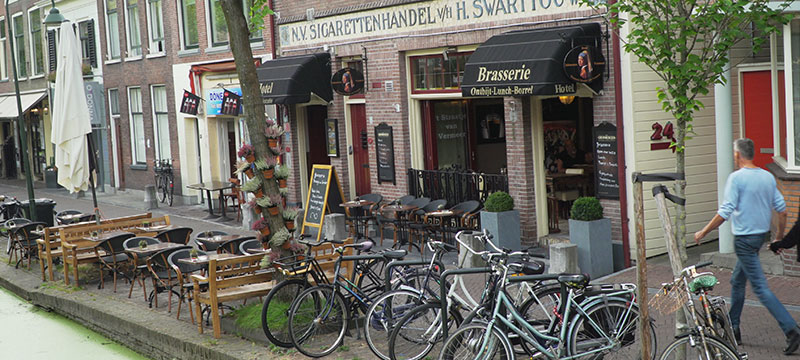
"Delft is a small city. We call it little Amsterdam, so it has a lot of canals, but also a lot of nice little secret streets where you can walk around, also very good to do it on boat or by bike. But it's really nice to just walk around and see all the nice old buildings, and all the people who live here, as well, some little nice houses. At a lot of students are living here."
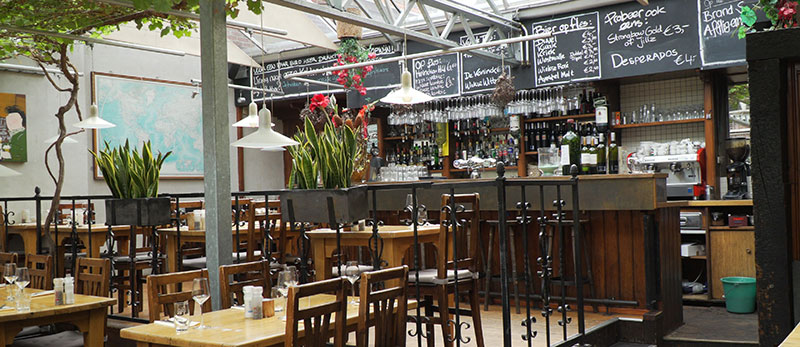
Walking a few blocks back over towards the city center we passed another restaurant, de Kurk, which bills itself as a gastropub – lots of different beers on tap and gourmet pub grub with a traditional, if simple, wood paneled interior.

You will see that Koornmarkt is a busy street. It's really a lot of fun to walk along here. Just watch out for the bicycles. Many shops and the canal running along it, with little bridges across the canal. We're right in the center just near the marketplace, heading for the Vermeer Center, a nice museum about the life of Vermeer.
As usual in this small city, it's only takes five or 10 minutes to walk there. And these really are some of the nicest blocks in town. This is as good as it gets, complete with several antique shops spilling out onto the sidewalk.
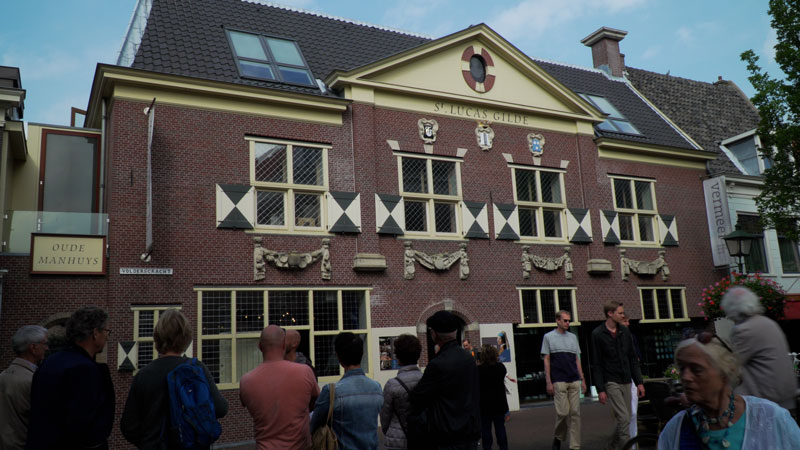
The Vermeer Center Delft is housed in a historic building that used to be a guild for creative people, a gathering place like a union hall for bookmakers, booksellers, potters and painters. They came here to socialize and discuss the arts and promote their businesses. Vermeer use to attend to this guild very often, including some periods when he was the chairman.
In the lower level they have an exhibit of his entire collection with copies of all 37 known pictures in the original size, high-quality digital reproductions. And they reconstructed what his studio might've looked like with some copies of implements and paintbrushes.
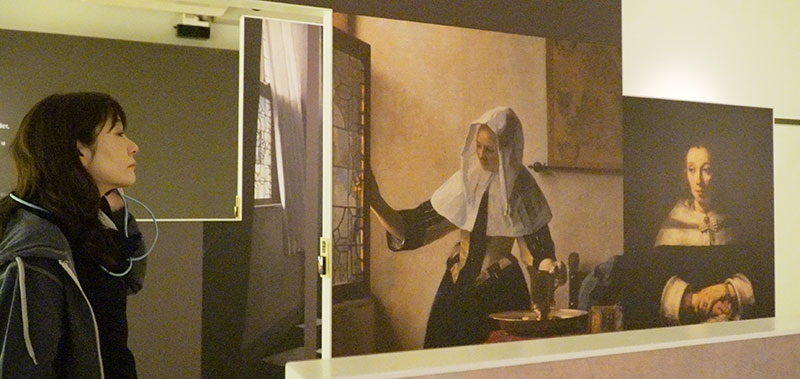
Vermeer lived in Delft his whole life and by the age of eight he lived across the street at an inn owned by his father, and later he went to live with his mother-in-law on the other side of the market square, so he always used to be around this area.
The museum also features some innovative multimedia displays and movies, and you will have an audio headphone set to guide you through. The museum is open every day from 10 to 5.
When you come out of the museum keep on walking along the Voldersgracht, a lovely canal with shops along one side of it. That's going to lead you to an intersection of several bridges which are among the most picturesque in town, including a bridge featured in that movie the Girl With The Pearl Earring, with Scarlett Johansson walking across it.
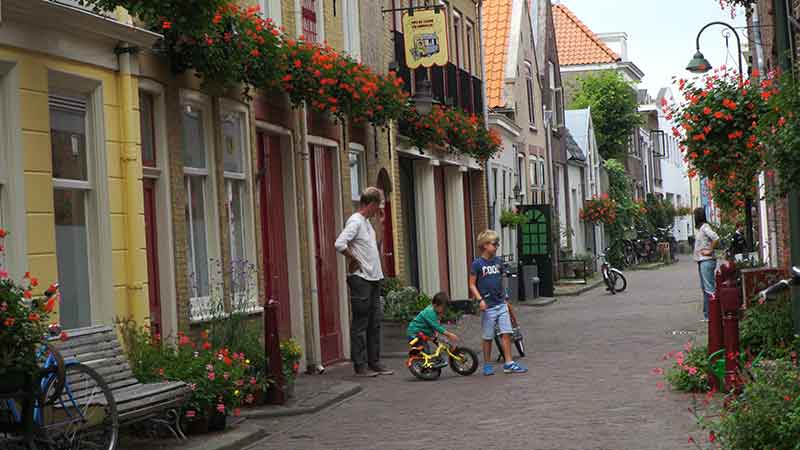
We are in a quaint neighborhood just behind the New Church (Nieuwe Kerk), the large building on the main market square. We will be taking you in there shortly. But now were going to have a walk around and look at some of the bridges and the side lanes here.
The Eetcafé de Ruif invites you to sit on their open terrace or on their dining boat that will surround you with peace but also give you an awesome view at the busy and picturesque streets of Delft. The bridge right next to Eetcafé is one of the most famous and picturesque in town.
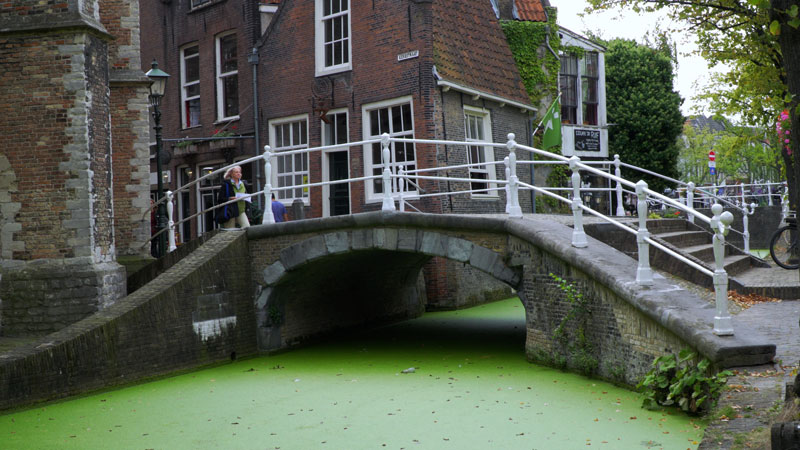
We're going to take you on a little wander around here for the next couple of minutes and show you the neighborhood just behind the New Church, quite near the marketplace, in a pedestrian zone of canals and wide sidewalks with many shops and restaurants.
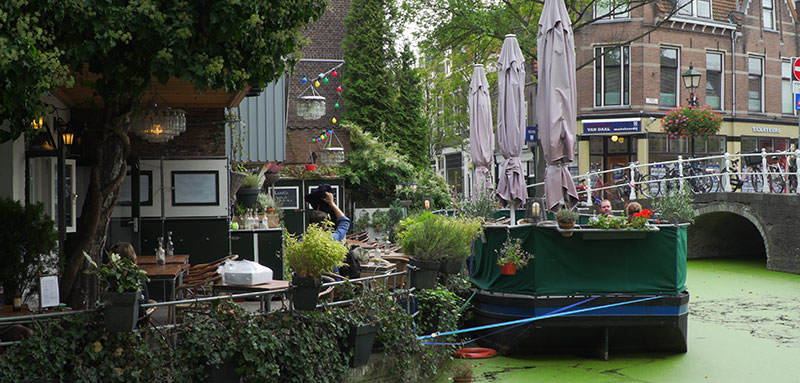
Each bridge is a little hill for the bicycles to go over and if you're not going fast enough, you need to use your foot to push you along. That's why most bicycles pedal along pretty quickly, with all these ups and downs they've got to navigate, so don't get in their way.
Nearby is the famous "Little Street", Nieuwe Langendijk. After much research, it was recently discovered that this is the location for one of Vermeer's most iconic paintings, as seen then and now. That painting is just one of only two of his surviving works that picture actual scenes in Delft. The remainder of his paintings are mostly portraits that were done inside his house, which was located a few blocks away over by the market square.
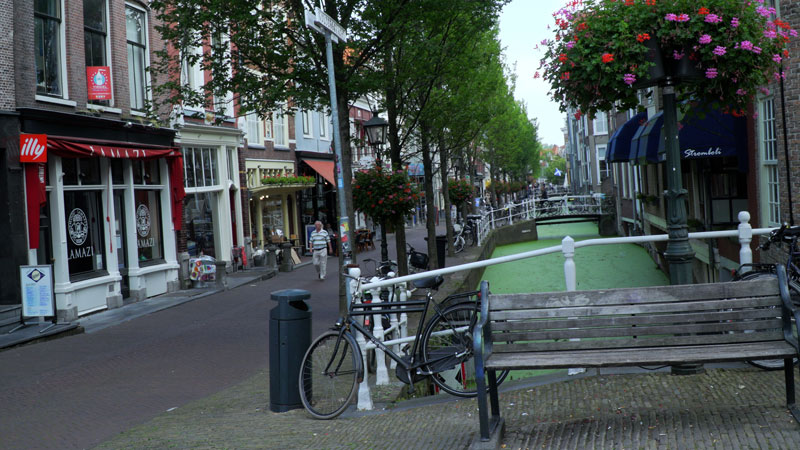
Nearly 700 buildings in Delft are listed as national monuments because of their beauty and their cultural historical value, which means that the owners need a permit before they're going to make any kinds of modifications to it.
That's one of the main reasons that Delft is looking so historic and is so well-preserved – there is a lot of government control that makes it happen. These buildings are protected inside and out, where you even need permission to clean the façade or change the color.
After going up and down a few of these canals, circle back towards the New Church and head to the other side of the market square to have a look at the street that Vermeer lived on for most of his life.
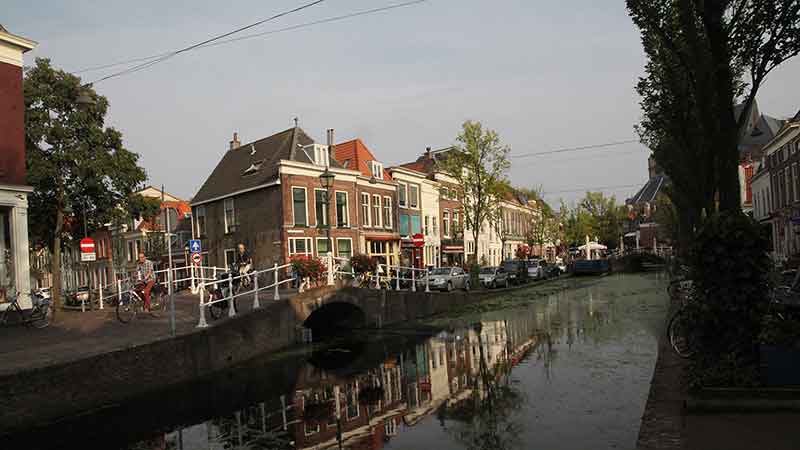
His house was on Oude Langendijk, and yet very little is actually known about Vermeer. It's quite a mystery. His actual house is gone but they say the location of it was probably right about where a tattoo parlor now stands, next to a church which has a sign on it commemorating this historic location.
That brings us back to the market square, where it is finally time for us to go to church. It's called the New Church even though it dates from the early 14th century, about 750 years old, so the name is something of a paradox, but at least it's newer than the Old Church (although some argue the Old Church was finished after the New Church, thus is newer). So it's all relative.
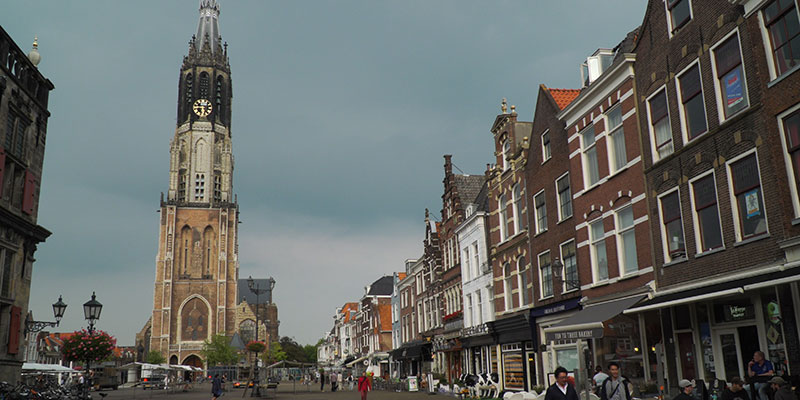
The church is most famous as the burial place of the Dutch Royal family, the House of Orange, featuring a remarkable funeral monument to William of Orange, also called William the Silent.
He is considered the father of the country because in 1572 he came here to live and work to lead the revolt against the occupying Spanish army, and he succeeded and defeated the Spaniards becoming the founder of the Netherlands. The church is still used for burials of some members of the Dutch Royal family, most recently in 2002 and 2004.
The Tourist Information Office is located on the market next to the New Church. They are known as VVV and can be very useful in your visit. You should stop in to get some free maps and information, tips on dining, walking tours, activities, and hotels. We had a chance to talk with one of their representatives about what to see and do in Delft. You can get around in a mini-bus shuttle if you're tired of walking. You can buy a ticket for all day, or a single ride on the little van.

"Delft is a beautiful city, a beautiful small town. It's a historical inner-city, a cozy inner city with a lot of shops, cozy restaurants, the Square. It's the perfect postcard town. And easy to see the whole place on foot. The longer you stay, the more details you will see, wooden buildings, with the museums within the historical inner-city.
"We've got Johannes Vermeer, world famous painter. He was born and raised here in Delft, and we've got Delft Blue, which is world-famous as well. Delft is a perfect home base. It is centrally located within Rotterdam and the Hague. It is only 10 minutes away by train, Gouda as well. Also Leiden and Utrecht are nearby, approximately 30 to 40 minutes. So it's the perfect base to cover all the metropolitan areas of the Netherlands.
"Delft is a very convenient place to live. It's like in a small town where everything is within hand reach. Delft is one of the biggest student cities. We've got the University, a well-known and quite famous and high-ranked university. It's a technical university, so we've not only got the historical but we've also got the new, a city of innovation technique."
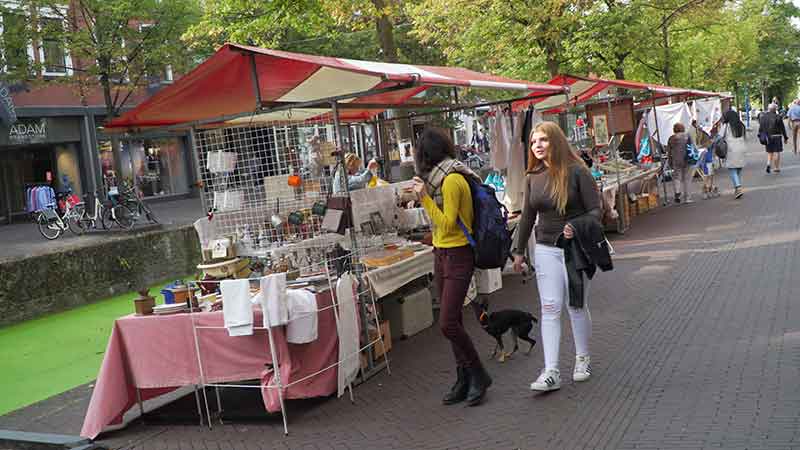
Another major pedestrian shopping street, Choorstraat, is just a few blocks north of the market square, where you might come across yet another canal with a street market, number three if you're keeping track. It's on lanes called Hippolytusbuurt and Wijnhaven.
This one's a lot of fun. It's kind of an antique general market. You can pick up some Royal Delft porcelain at a bargain price. Get some clothing, knick-knacks, some antiques maybe.
You might call it a flea market but it's a little bit more upscale, very nice stuff. It happens on Thursdays, but it's even bigger on Saturday. They're not selling food here, they're not selling regular clothing. Oh, there's some fabrics and various vintage items.
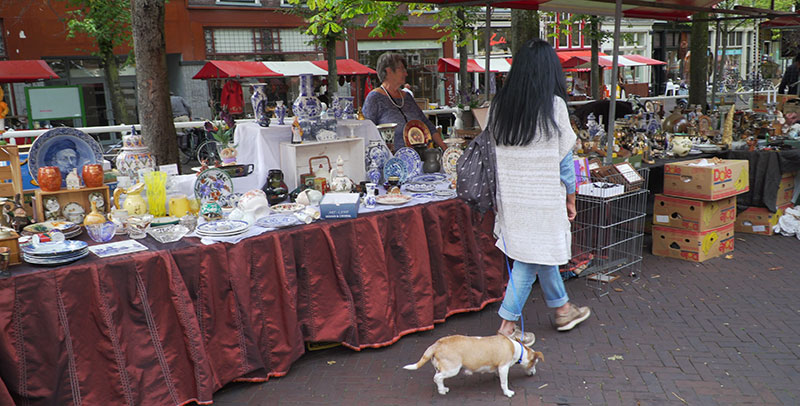
It's the kind of place where you can strike up conversation with the locals. It extends right up to the Old Church where we are going next.
The unusual bridge that has a small terrace down at the water level. There's a stone staircase called the Mosseltrap that leads down to the water because muscles, the shellfish, were brought here by ship until the 19th century.
That leads us next door to the Old Church, which dates from 1246 and that makes it the oldest church in Delft, built in the Gothic style.
Both the New Church and Old Church have international allure because of all the famous people from Dutch history who have been interred within their walls. Here we have burials of Johannes Vermeer, the scientist Anthony van Leeuwenhoek and also an Admiral Martin Tromp who helped defeat the Spanish back in the 16th century, fighting against the mighty military of King Philip the Second of Spain.
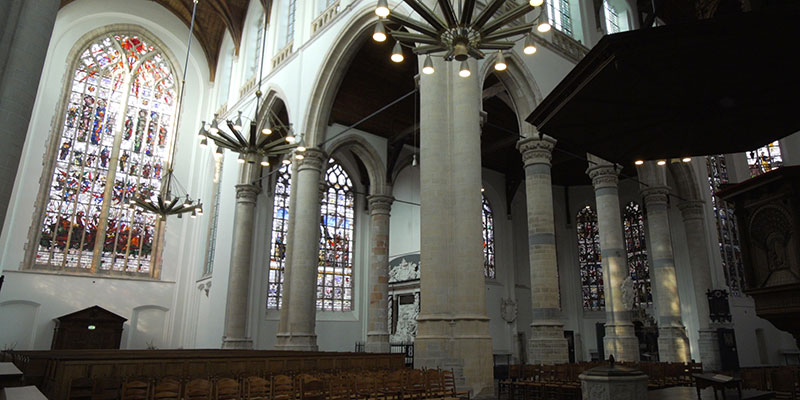
It's quite remarkable to see the amount of stained-glass windows in this very early Gothic church. The light comes flooding in. Some of the windows are colored and others are plain glass to give that effect of brightness and heaven inside the church.
Of course there were many renovations and expansions and reconstructions of the church during its centuries of existence. The organs here and also back in the New Church are often played as part of concert performances open to the public.
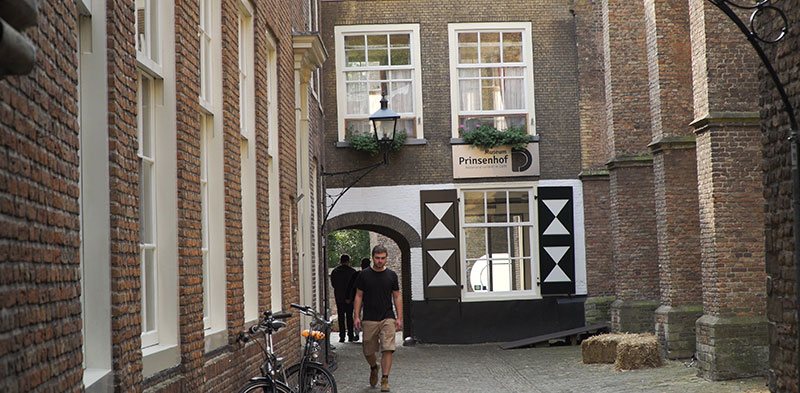
Just behind the church is a very important historic site called Prinsenhof. It was the Court of the Prince back in the Middle Ages. Originally it was a monastery and later served as a residence for William of Orange, considered the founder of the country, who was murdered here in 1584. The museum today is open to the public. They have changing exhibits as well as their permanent collection.
Around the corner along the Old Delft canal you'll find a convenient hotel, Museumhotels Delft. Beyond this point towards the north it's a mostly residential district. So unless you've got lots of time, you really don't need to venture further north.
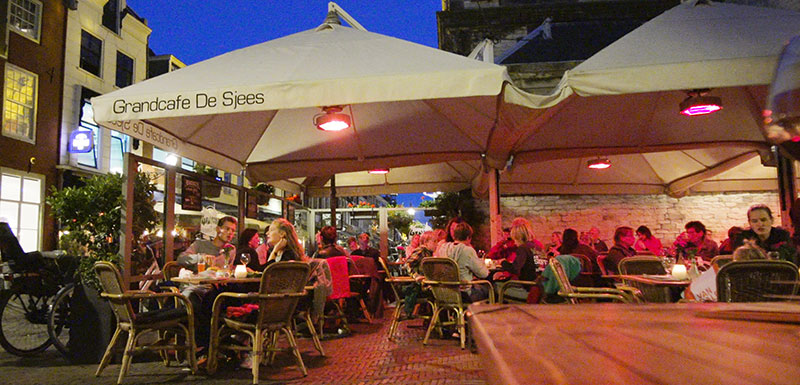
You definitely want to explore Delft at twilight and into the evening. Come on out, have a drink and have some dinner, stroll through the beautifully-lit streets, especially in the neighborhood around the marketplace. Not only is it the historic center, but it's considered downtown Delft by the local residents. This is where they come to party and walk and see their friends.
It's quite safe to be out walking at night. Don't worry about any danger because the crime rate in the Netherlands is much lower than America, for example, because the Dutch have created a society that takes care of everybody.
We suggest two more activities for tomorrow morning: a boat ride in the canals and a visit to the Royal Delft factory to see how they make the Delftware.
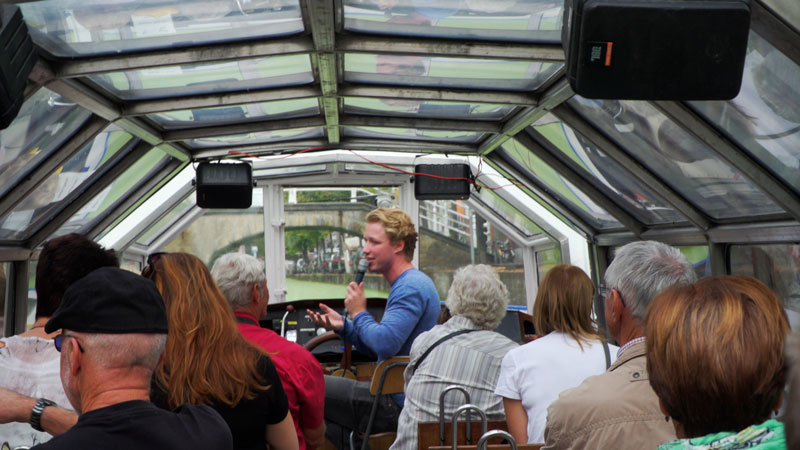
We took the canal boat tour with the company called Rondvaartdelft. They've been doing this for 50 years so they really have experienced captains and guides. And they take you on a nice short route offering quick scenes of the historic buildings gliding while going under the bridges.
Their brochure claims the guides are all passionate and knowledgeable about the rich history so we wanted to talk to one of the guides and get his story.
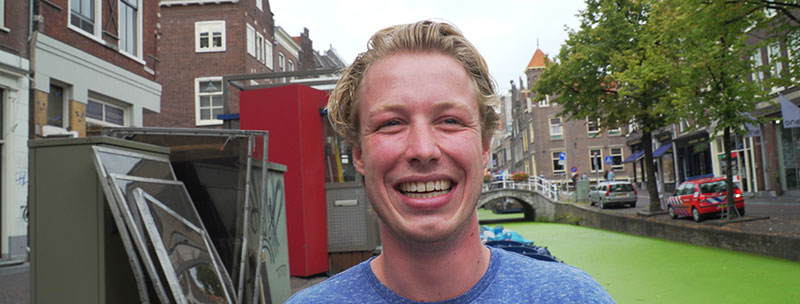
“I’m a full-time student here studying mechanical engineering, where I just finished my bachelor and I'm now going to do my Masters here in Delft. So in two years I will be graduated. I like Delft, and it's a good University here, it's only technical, so I like that.”
“And this is a good job, you're outside all day long, just entertaining some people, so that's fine. This is a part-time job. I do this about 4 to 5 times a month. They mostly work with about 40 students, but you make kind of good money. If the people tip good,” he says, laughing.
Continue walking south towards the Royal Delft factory and showroom, slightly beyond the historic center that we've been spending time at but still a lovely neighborhood with a mix of new and old, passing Breestraat, which is a direct route over to the train station just a block away from here, so you might see people hauling their bags to the train station. The factory is about 1 kilometer from the train station and nearly 2 kilometers from the Markt central square. You could also get there on the tiny shuttle bus.
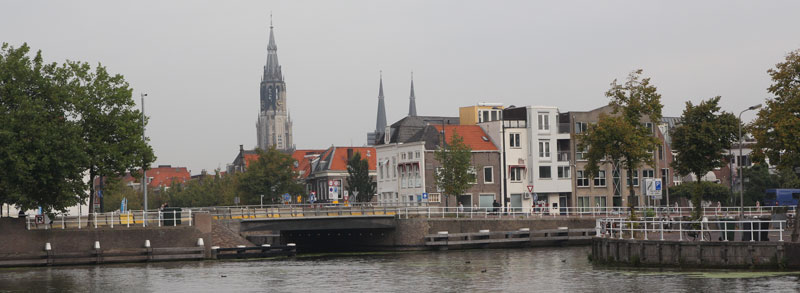
When you reach the small harbor along Zuideinde street look back over your shoulder to get the same angle as Vermeer's famous View of Delft, looking at the old warehouses. At this point, the river is called Schie, and gets quite wide with direct shipping connections to Leiden and Rotterdam, and from there out to the North Sea or down the Rhine River. It's a growing part of town with some modern apartments enjoying a lovely waterfront view.
Which brings us right to the Royal Delft showroom and factory where we are going to enjoy a tour of the facilities. These tours are open to the general public for slight admission fee, or you're welcome to come into the showroom, the sales room without any entrance charge at all.
Our guide took us on the factory tour.
"So welcome to Royal Delft. We’re going to take you on a little walk through our factory covering our long history. We’re going to show you during our tour our museum, you're going to watch the painters work, and admire the beautiful collection in our showroom."
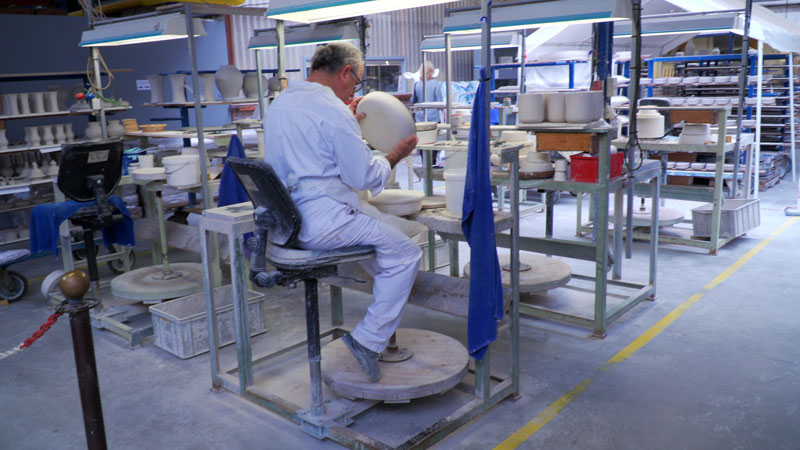
Here they reveal the magic of how clay is transformed into a variety of wonderful porcelain ceramic vessels. You'll get to see how many of these pieces are hand-painted. The decorating process starts with the creation of the outline of the traditional decoration, after which the painters carefully fill in the details by hand using special paint brushes made of marten and squirrel hair. And you'll see a ceramic reproduction of the most famous painting in the Netherlands, Rembrandt's Night Watch.
The Delft blue scenery is painted with a color mixture made to a centuries old recipe, consisting mostly of cobalt oxide. After the piece has been hand-painted it's sprayed with a glaze. Now the glaze covers the decoration with an opaque white layer, and then during the firing process, the glaze melts at a temperature of 1200°C into a transparent layer of glass. And with the chemical reaction during the firing process, the design painted in black, hidden below, comes out a rich Delft blue with a strong and shiny glazed surface.
Most of the pieces are made here in molds. They pour the liquid clay into the plaster mold. It coats the clay to the walls of the mold, forming a cast inside that dries and can then be removed.
Then each article has to be finished by hand using a sponge and a knife. When it's perfect it's ready for the first firing process. That happens in one of our five kilns. The firing process takes 24 hours, that's including cooling down, and the temperature is about 1100 degrees.
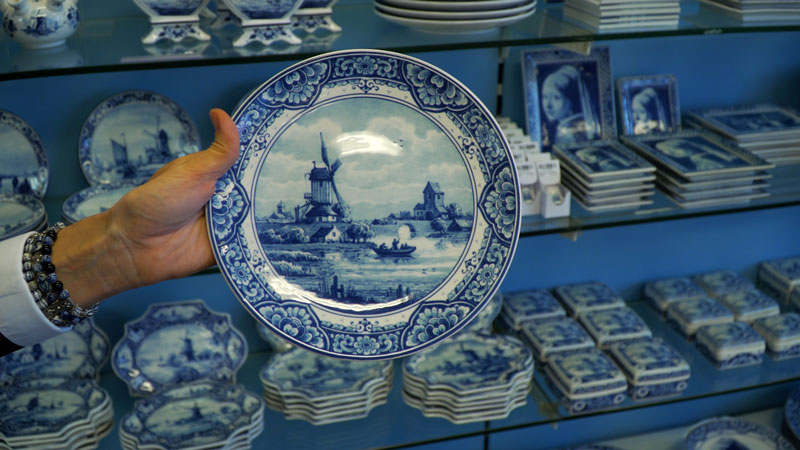
Not all of the pieces are hand-painted because that's more expensive, so there's another technique that utilizes a transfer, like a decal. They put the decal in hot water, place it on the handmade plate collection, and then during a final firing process, the decoration fuses into the glaze. The decals are custom designed by the painters of the workshop. This is the handmade collection but not hand-painted, created with the transfer technique.
You'll also visit their museum collection which includes a room in tribute to Vermeer who worked in Delft at the same time this company was founded.
"This is our Royal collection. Our name of course is Royal Delft. We do have a very special relationship with the members of the Dutch Royal family, so we have the honor to realize with our beautiful commemorative plates, special occasions, but also the portraits.
So here you can admire the modern collection where we like to maintain the tradition but we also like the challenge to go to modern designers."
There is a big display of the Christmas plate collection. Each year one of their best master painters realized a new design with a Christmas theme.
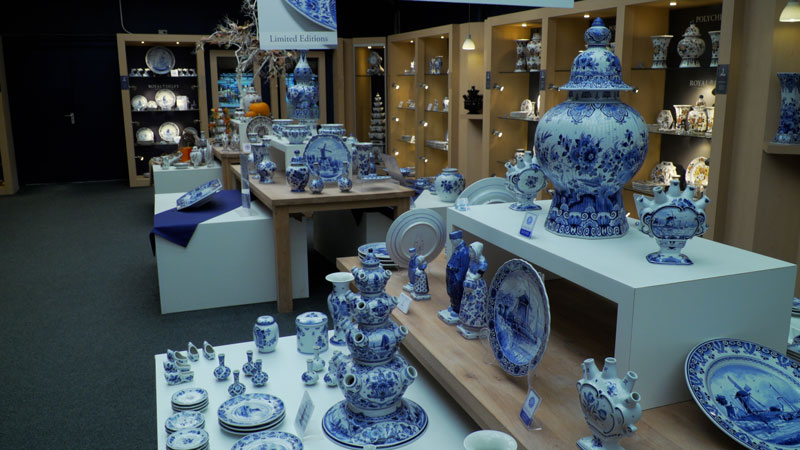
The history of this company is quite amazing. Dutch interest in porcelain dates back to 1600 when the Dutch East India Company brought back some blue painted porcelain from China.
And they kept importing it, but because of problems with Chinese trade and civil wars, the Dutch needed to figure out a way to make it for themselves, which they did very successfully. And it helped that they had a number of breweries making beer that were going out of business back in the 1650s, leaving some of the buildings in Delft vacant and they were perfect for making pottery, because they had kilns and plenty of storage space.
The Royal Delft Company actually got started back in those days in 1653, and it's been in business continuously ever since. Back in those days there were 32 different earthenware factories in Delft. The industry began a decline back in the 1800s because of competition from other countries, from England, Ireland and from other European countries that had cheaper porcelain, but Royal Delft continued operations under various ownership, continually growing stronger and more famous.
In 2003, they celebrated their 350th anniversary and in 2012 they opened up the present showroom to the public.
And that, my friends, completes our comprehensive look at the city of Delft.
See more pictures in the Gallery.
Map of Delft places